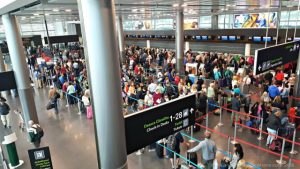While we have all had bad flights once in a while, my experience this weekend has led me to question if the current trend toward hiper efficiency and out sourcing is really a good idea – especially considering the number of strategic and operational risks that business is faced with today.
The story
 After 3 gate changes and waiting for a 20 minutes outside on the tarmac me and 188 other passengers finally boarded our Ryan Air flight from Dublin to Barcelona on Friday night. Since I was sitting in the front of the plane, I had a great view of the maintenance operative trying to get the front door of the Boeing 737-800 to close. The man was wearing a vest that was probably orange when it was new and he looked like he had been on a very long shift. After opening and closing the door a number of times and peering closely at its mechanism, the operative went to report to the Captain of the plane who decided not to risk flying that aircraft.
After 3 gate changes and waiting for a 20 minutes outside on the tarmac me and 188 other passengers finally boarded our Ryan Air flight from Dublin to Barcelona on Friday night. Since I was sitting in the front of the plane, I had a great view of the maintenance operative trying to get the front door of the Boeing 737-800 to close. The man was wearing a vest that was probably orange when it was new and he looked like he had been on a very long shift. After opening and closing the door a number of times and peering closely at its mechanism, the operative went to report to the Captain of the plane who decided not to risk flying that aircraft.
Fortunately, since we were in Dublin, Ryan Air was able to find another plane in about an hour and after another 30 minutes of planning, we all went back to the terminal and eventually boarded a different 737. This was made more complicated because it seems the crew needs to be on board when passengers get off and also when they get on so it was not possible to walk from one aircraft straight onto the other one and there were no extra pilots available to help.
The guys at the terminal who marshaled us off and on the two planes were friendly but did not seem to be in close communication with our pilots or anyone at Ryan Air. They even allowed some of us to get on the new plane before the pilot had made it over there so we had to get off again and wait around until he could do his pre-flight check properly.
Even the pre-flight gate changes had a provisional air about them. At one point everyone is in line and then the destination simply changes and when asked where we should go, the young men and women suggest we check the information screens. The idea that someone would make a calm announcement apologizing for the confusion but asking us to go to Gate 116 simply did not occur to the overworked and stressed out staff.
The good news is that at 1:30 AM we finally did arrive in Barcelona and I am glad the pilot chose the safest option for making the trip. Of course had we been anywhere besides Dublin, it is very unlikely that Ryan Air would have another plane and possible that they would have no Ryan Air employees at the terminal at all.
The Moral
The reason I decided to take time away from important issues connected with the environment and the world’s geo-political situation to tell this story is that I think there is a wider problem than one professor’s bad airline experience. Back in July last year another low cost airline, Vueling, had a systemic collapse, and I wrote a post talking about resilience and the lack thereof in an increasing number of companies.
In my view a business must build some degree of resilience into its operational model in order to assure that it can get through small and large problems. While Ryan Air’s approach to outsourcing and operating at the lowest possible cost has made travel affordable for the public and profitable for its shareholders, it has also introduced a degree of risk into getting from point A to B.
 There are, of course, more significant risks than one aircraft’s forward door and my experience this weekend makes me wonder how well equipped many companies, particularly those pursuing a low cost strategy, are positioned to face those risks.
There are, of course, more significant risks than one aircraft’s forward door and my experience this weekend makes me wonder how well equipped many companies, particularly those pursuing a low cost strategy, are positioned to face those risks.
In my view every board of directors should ask for a deep analysis of the resilience of the operations and supply chain of their companies with clear trade off analysis showing risks and the cost of their mitigation. It might even makes sense to sacrifice 1-2% of net margin in exchange for greater peace of mind.

